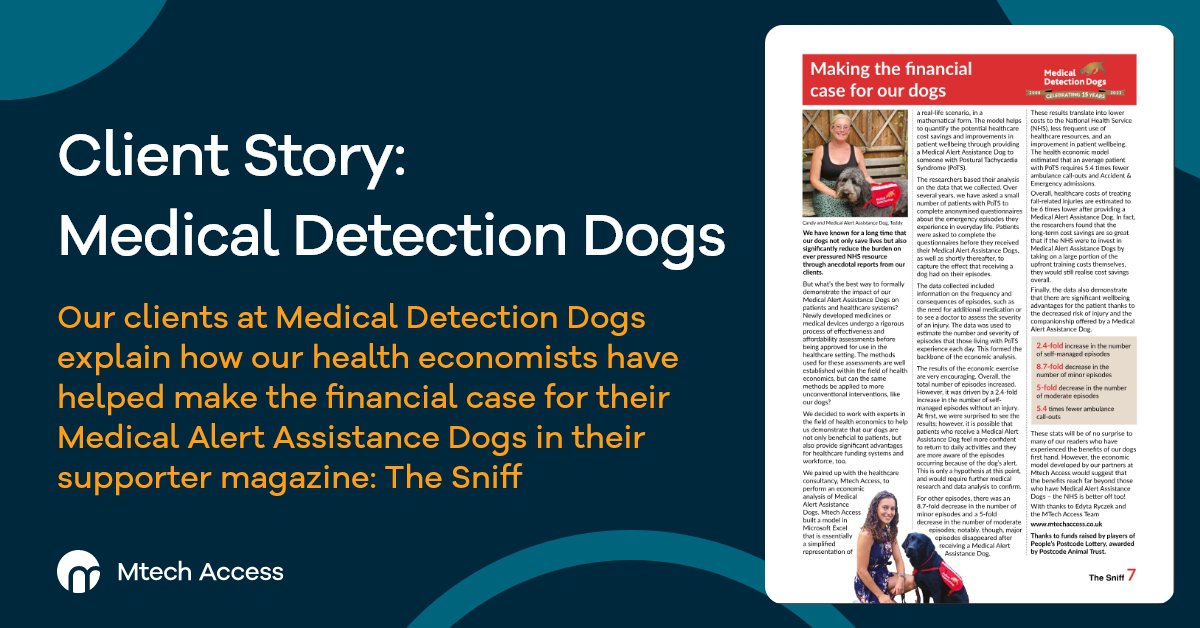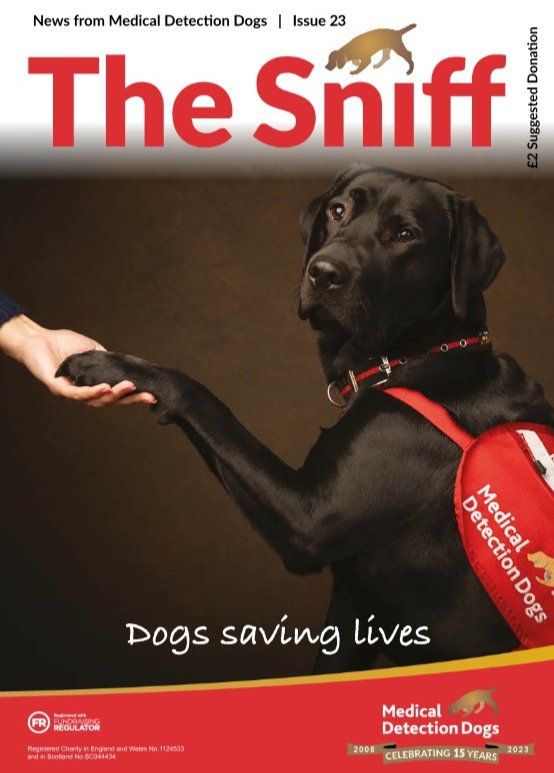
Our clients at Medical Detection Dogs recently published this article in their news magazine ‘The Sniff’ describing our work with them. We developed a health economic model to demonstrate the value their Medical Alert Assistance Dogs deliver for patients and healthcare systems.
This is how our clients at Medical Detection Dogs told their story in The Sniff:
Making the financial case for our dogs
We have known for a long time that our dogs not only save lives but also significantly reduce the burden on ever pressured NHS resource through anecdotal reports from our clients.
But what’s the best way to formally demonstrate the impact of our Medical Alert Assistance Dogs on patients and healthcare systems? Newly developed medicines or medical devices undergo a rigorous process of effectiveness and affordability assessments before being approved for use in the healthcare setting. The methods used for these assessments are well established within the field of health economics, but can the same methods be applied to more unconventional interventions, like our dogs?
We decided to work with experts in the field of health economics to help us demonstrate that our dogs are not only beneficial to patients, but also provide significant advantages for healthcare funding systems and workforce, too.
We paired up with the healthcare consultancy, Mtech Access, to perform an economic analysis of Medical Alert Assistance Dogs. Mtech Access built a model in Microsoft Excel that is essentially a simplified representation of a real-life scenario, in a mathematical form. The model helps to quantify the potential healthcare cost savings and improvements in patient wellbeing through providing a Medical Alert Assistance Dog to someone with Postural Tachycardia Syndrome (PoTS).
The researchers based their analysis on the data that we collected. Over several years, we have asked a small number of patients with PoTS to complete anonymised questionnaires about the emergency episodes they experience in everyday life. Patients were asked to complete the questionnaires before they received their Medical Alert Assistance Dogs, as well as shortly thereafter, to capture the effect that receiving a dog had on their episodes.
The data collected included information on the frequency and consequences of episodes, such as the need for additional medication or to see a doctor to assess the severity of an injury. The data was used to estimate the number and severity of episodes that those living with PoTS experience each day. This formed the backbone of the economic analysis.
The results of the economic exercise are very encouraging. Overall, the total number of episodes increased. However, it was driven by a 2.4-fold increase in the number of selfmanaged episodes without an injury. At first, we were surprised to see the results; however, it is possible that patients who receive a Medical Alert Assistance Dog feel more confident to return to daily activities and they are more aware of the episodes occurring because of the dog’s alert. This is only a hypothesis at this point, and would require further medical research and data analysis to confirm.
For other episodes, there was an 8.7-fold decrease in the number of minor episodes and a 5-fold decrease in the number of moderate episodes; notably, though, major episodes disappeared after receiving a Medical Alert Assistance Dog.
These results translate into lower costs to the National Health Service (NHS), less frequent use of healthcare resources, and an improvement in patient wellbeing. The health economic model estimated that an average patient with PoTS requires 5.4 times fewer ambulance call-outs and Accident & Emergency admissions.
Overall, healthcare costs of treating fall-related injuries are estimated to be 6 times lower after providing a Medical Alert Assistance Dog. In fact, the researchers found that the long-term cost savings are so great that if the NHS were to invest in Medical Alert Assistance Dogs by taking on a large portion of the upfront training costs themselves, they would still realise cost savings overall.
Finally, the data also demonstrate that there are significant wellbeing advantages for the patient thanks to the decreased risk of injury and the companionship offered by a Medical Alert Assistance Dog.
- 2.4-fold increase in the number of self-managed episodes
- 8.7-fold decrease in the number of minor episodes
- 5-fold decrease in the number of moderate episodes
- 5.4 times fewer ambulance call-outs
These stats will be of no surprise to many of our readers who have experienced the benefits of our dogs first hand. However, the economic model developed by our partners at Mtech Access would suggest that the benefits reach far beyond those who have Medical Alert Assistance Dogs – the NHS is better off too!
With thanks to Edyta Ryczek and the Mtech Access Team
This story was originally published in Medical Detection Dogs’ magazine ‘The Sniff’ on page 7: https://indd.adobe.com/view/32bdb0a6-6ff0-47e7-a01c-4d7e3f45e490

If you would like to learn more about our work with organisations like Medical Detection Dogs or our expertise in health economic modelling, please email info@mtechaccess.co.uk.


